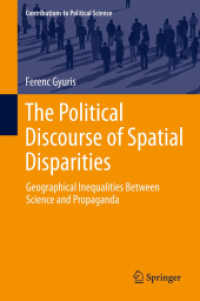Full Description
What exactly is self-control, and what life outcomes does it affect? What causes a person to have high or low self-control to begin with? What effect does self-control have on crime and other harmful behavior?
Using a clear, conversational writing style, Self-Control and Crime Over the Life Course answers critical questions about self-control and its importance for understanding criminal behavior. Authors Carter Hay and Ryan Meldrum use intuitive examples to draw attention to the close connection between self-control and the behavioral choices people make, especially in reference to criminal, deviant, and harmful behaviors that often carry short-term benefits but long-term costs. The text builds an overall theoretical perspective that conveys the multi-disciplinary nature of modern-day self-control research. Moreover, far from emphasizing only theoretical issues, the authors place public policy at the forefront, using self-control research to inform policy efforts that reduce the societal costs of low self-control and the behaviors it enables.
Contents
Chapter 1: Introduction
A Definition of Self-Control
An Integrative Approach
A Life Course Approach
Connecting Self-Control to Other Causes of Behavior
Attention to Public Policy
Connecting the Science of Self-Control to the Stories We Read About Everyday
Chapter 2: Theories of Self-Control and Behavior
The Inextricable Connection Between Theory and Fact
Explaining Crime: Gottfredson and Hirschi's Self-Control Theory
Evaluating Gottfredson and Hirschi's Self-Control Theory
A Psychological, Trait-Based Theory of Self-Control
Biosocial Approaches to Behavior
The Strength Model: Self-control as a Depletable Resource
Chapter 3: What Are the Consequences of Low Self-Control?
The Marshmallow Experiments
A Quick Note on the Measurement of Self-Control
Research on Low Self-Control and Crime
The Everyday Consequences of Low Self-Control
Policy Implications and Possibilities
Chapter 4: Infancy and Childhood: What Are the Causes of Self-Control Early in Life?
The Role of Parents in Shaping Self-Control
The Genetic Underpinnings of Self-Control
Neurobiological Influences on Self-Control
Policy Implications and Possibilities
Chapter 5: Adolescence and Adulthood: Is Self-Control Stable Over Time?
Stability and Change in Self-Control
Why Does Self-Control Often Remain Stable?
Persistent Individual Traits as Contributors to Self-Control Stability
Persistent Environmental Characteristics: Parenting and Peers
Persistent Environmental Characteristics: The Stability of Poverty
State Dependence as a Contributor to Self-Control Stability
An Implicit Idea: Human Agency
Empirical Evidence on Explanations for Stability
Policy Implications and Possibilities
Chapter 6: What Leads to Self-Control Change?
The Pervasiveness of Change
The Transformations of Adolescence
Unexpected Shifts in Social Environments and Relationships
Sleeping, Eating, and Substance Use: Short-Term Fluctuations in Self-Control
Policy Implications and Possibilities
Chapter 7: Do the Harmful Effects of Low Self-Control Vary Across Different Circumstances?
Conditional Causation and Low Self-Control: Conceptual Issues
Criminal Opportunity
Association With Delinquent Peers
Weak Social Bonds
Neighborhood Disadvantage
Weak Moral Values
Considering Self-Control as a Moderator Variable
Can Self-Control Moderate the Effects of Self-Control?
Policy Implications and Possibilities
Chapter 8: Self-Control and Crime Over the Life Course: Bringing It All Together
The Causes of Initial Self-Control Differences in the First Decade of Life
The Child Grows into an Adolescent
The Adolescent Grows Into an Adult
Moderated Effects Across the Entire Life Course
Chapter 9: Self-Control and Crime: Influencing Policy and Looking to the Future
Self-Control as a Driver of Societal Advance
Using Policy to Promote Self-Control Over the Life Course
Community-Based Programs Relevant to All Stages of the Life Course
Evidence of Program Success








